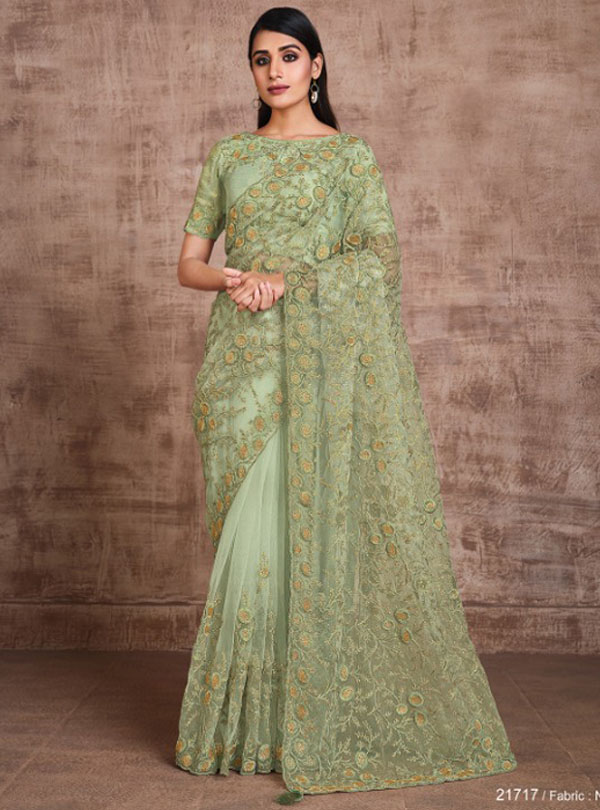We all know that the traditional yet fashionable nine-yard sari is the perfect attire to wear to a variety of ceremonies and events. If draped properly, a saree’s beauty, charm, and grace are absolutely alluring.
Without a doubt, any young lady’s mother is the ideal educator for teaching her how to drape a saree gracefully. But, what if you live alone or in a remote location and are looking for a suitable saree draping solution? We’re here to assist you with the best steps to drape a saree in a perfect way.
Here Are The Best Steps To Drape A Saree In A Perfect Way
Step 1: After you’ve put on your blouse and petticoat, you can start draping the saree. Keep the saree basics with you now, like accessories, pins, and high heels, as they are essential to wearing a sari correctly.
Step 2: Tuck your saree into your petticoat, which you should adjust to your comfort. Using the plain end of the sarees, tie a knot and tuck it inside the petticoat. Make sure that the embroidery work on the sarees is in front of you when tying the knot.
Step 3: Continue swaddling the sarees on the left side of your body until you reach the spot where you began. Just make sure you swaddle your sari for one entire round. In addition, once you’ve finished wrapping your sari, make sure the lower end is a little higher than the floor.
Step 4: After that, you’ll have some extra fabric, which you’ll need to use to form pleats. You must make flawless pleats with your thumb and middle finger while making the pleats.
Step 5: Make 5 to 7 pleats, depending on your saree’s fabric, to give your saree a fascinating look. After forming the pleats, fold them inside the petticoat. Safety pins are used to attach the saree, particularly on the left side of the waist. Using pins to secure the sari will keep it completely intact and allow you to carry it comfortably.
Step 6: All that’s left now is to style the pallu. You must first place the pallu of the sari over your left shoulder before styling it. Alternatively, you could unfold one or two pleats to make your pallu as long as you like or even reach your knees.
Step 7: Now attach your pallu with the safety pins once more. Furthermore, you have two options when it comes to pallu styling: you can maintain it pleated or let it flow freely. To pull off the look, both pallu styles are simply stunning. If you prefer a flowing style pallu, just put it on your left shoulder and hold it at the forearm or leave it like that; the choice is entirely yours.
Step 8: If you wish to produce a pleated pallu, you must pleat the pallu vertically. First and foremost, depending on the width of your sari, you must pleat around 7 to 8 times. Second, pin the pallu to the inside of your blouse with safety pins. Finally, you’re ready in your traditional and classic sari style, and you can glam it up by adding a lovely brooch to the sari, especially if you’ve made sari pleats.
A Little About Saree
There are a variety of saree facts that can be helpful to someone who is new to the realm of traditional fashion. This includes information on different types of sarees, blouses, draping, style, and accessories. Women would find it extremely easy to dive into the exciting world of sari shopping to get the appropriate outfit/s for various occasions with such useful tips and tactics at their fingertips.
One of the most intriguing aspects of this gorgeous outfit is that it comes in a wide range of styles and colours. Despite the fact that all saris are essentially the same, the nuances that affect the overall appearance of the outfit might vary. To grasp the many types of sarees, you must first understand what the garment is all about. It’s just a long piece of material that’s wrapped around the waist and draped across the torso in a specific way. Under the sari, a shirt and long skirt (known as the petticoat) are worn to give it greater structure and modesty.
When it comes to the Indian saree, sorting through facts on the various varieties might take a long time. There are so many types to pick from that it might be overwhelming for someone who has little or no experience with ethnic design. Comfortable cotton and linen materials, close-fitting georgette and diaphanous chiffon, fine net and tissue, as well as woven silk and brocade from various regions of India, are among the fabric options.
Also Check This, Unique Ways To Drape A Saree Perfectly






